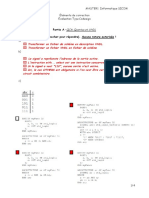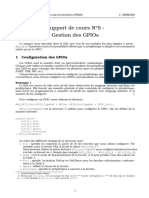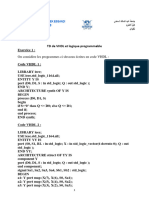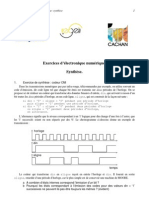Serie TD4 Bis
Serie TD4 Bis
Transféré par
Sarah NourDroits d'auteur :
Formats disponibles
Serie TD4 Bis
Serie TD4 Bis
Transféré par
Sarah NourDescription originale:
Titre original
Copyright
Formats disponibles
Partager ce document
Partager ou intégrer le document
Avez-vous trouvé ce document utile ?
Ce contenu est-il inapproprié ?
Droits d'auteur :
Formats disponibles
Serie TD4 Bis
Serie TD4 Bis
Transféré par
Sarah NourDroits d'auteur :
Formats disponibles
ECOLE NATIONALE POLYTECHNIQUE
Département d’Electronique
Modélisation et Synthèse des Circuits Logiques
1° Année Registres et Compteurs
Série d’Exercices
Les Registres
Exercice 1
1. Donner une description structurelle d’un 4-bit register with asynchronous reset
registre de mémorisation (Buffer) 4 bits à base de LIBRARY ieee ; USE ieee.std_logic_1164.all ;
ENTITY reg4 IS
flip flops D à reset asynchrone. PORT (
D : IN STD_LOGIC_VECTOR(3 DOWNTO 0) ;
Resetn, Clock : IN STD_LOGIC ;
Q : OUT STD_LOGIC_VECTOR(3 DOWNTO 0) ) ;
END reg4 ;
ARCHITECTURE behavioral OF reg8 IS BEGIN
PROCESS ( Resetn, Clock )
BEGIN
IF Resetn = '0' THEN Q <= "0000" ;
ELSIF rising_edge(Clock) THEN Q <= D ;
END IF ;
END PROCESS ;
END behavioral ;`
N-bit register with asynchronous reset
LIBRARY ieee ; USE ieee.std_logic_1164.all ;
ENTITY regn IS GENERIC ( N : INTEGER := 16 ) ;
- Déduire le code VHDL (structurel) d’un PORT (
registre de mémorisation générique de talle N. D :IN STD_LOGIC_VECTOR(N-1 DOWNTO 0) ;
2.écrire le code VHDL de version Resetn, Clock : IN STD_LOGIC ;
comportementale de ce registre (4bits). Q :OUT STD_LOGIC_VECTOR(N-1 DOWNTO 0) ) ;
END regn ;
- Déduire le code VHDL comportemental d’un ARCHITECTURE behavioral OF regn IS BEGIN
registre générique (N bits) PROCESS ( Resetn, Clock ) BEGIN
IF Resetn = '0' THEN Q <= (OTHERS => '0') ;
ELSIF rising_edge(Clock) THEN Q <= D ;
END IF ; END PROCESS ; END behavioral ;
Exercice 2 Registre A Décalage
1.Donner le code Vhdl d’ un registre à décalage
simple sur 6 bits, avec une entrée série.
2. Le pré chargement est maintenant en parallèle et
réalisé à l’aide de 6 interrupteurs. modifier le code
source précédent. L’ordre de pré chargement sera
donné par un interrupteur indépendant.
3. Modifier le code source pour obtenir un registre à
recirculation. IF Resetn = '0' THEN qt <= "000000" ;
Solution question 1 ELSIF rising_edge(Clock) THEN
-- 6-bit Shift_register with asynchronous reset
LIBRARY ieee ; USE ieee.std_logic_1164.all ;
ENTITY Shift_reg6 IS
PORT (
SerIN : IN STD_LOGIC;
Resetn, Clock : IN STD_LOGIC ;
SerQ : OUT STD_LOGIC ) ;
END 6-bit Shift_register ;
ARCHITECTURE behavioral OF Shift_reg is 6 END IF ;
Signal qt : std_logic_vector(5 downto 0); IS END PROCESS ;
BEGIN SerQ <= qt(6);
PROCESS ( Resetn, Clock ) END behavioral ;`
BEGIN
;
ENP/ ELN/ 1 Année Modélisation et Synthèse des Circuits Logiques MSCL
Taghi Serie de TD N°4 Page 1
Solution question 2 --6-bit shift register with parallel load
LIBRARY ieee ; ARCHITECTURE behavioral OF shift4 IS
USE ieee.std_logic_1164.all ; SIGNAL Qt : STD_LOGIC_VECTOR(5 DOWNTO 0);
ENTITY Shift_reg6 IS BEGIN PROCESS (Clock)
PORT ( D : IN std_logic_vector(3 downto 0) ; BEGIN IF rising_edge(Clock) THEN
Enable : IN STD_LOGIC ; IF Load = '1' THEN
Load : IN STD_LOGIC ; Qt <= D ; ELSIF Enable = ‘1’ THEN
Sin : IN STD_LOGIC ; Qt <= Sin & Qt(3 downto 1);
Clock : IN STD_LOGIC ; END IF ; END IF ;
Q : OUT STD_LOGIC_VECTOR(5 DOWNTO 0) ) ; END PROCESS ;
END Shift_reg6 ; Q <= Qt; END behavioural
Exercice 3
Donner le schéma d'un registre 3 bits Utiliser des bascules D synchrones à front
programmable, à écriture et lecture en série par montant. Écrire le programme VHDL
décalage à droite ou à gauche, circulaire ou non. correspondant.
Prévoir deux entrées de programmation P1 et P2,
et donner le code de programmation choisi.
Exercice 4- Registere à décalage universel
Solution incomplète
1- Etablir le code vhdl d’un registre univesel Library ieee;
decrit ci-après use ieee.std_logic_1164.all;
use ieee.std_logic_unsigned.all;
use ieee.numeric_bit.all;
entity univ_shiftreg1 is port(
clk, il, ir : in bit; s: in bit_vector(1 downto 0);
i : in bit_vector(3 downto 0);
q : out bit_vector(3 downto 0));
end univ_shiftreg1;
architecture beh1 of univ_shiftreg1 is
signal qtmp : bit_vector(3 downto 0);
begin
process(clk)
begin if (clk = '1' and clk'event) then
case s is
when "00" => qtmp <= qtmp;
initialisation (INIT) when "01" => qtmp <= i;
lecture série ou parallèle (SSD, SSG, ou Qi) when "10" => qtmp<=qtmp(2 downto 0) & ir;
décalage à droite et à gauche (SENS) when "11" => qtmp<=il & qtmp(3 downto 1);
chargement série ou parallèle (MODE, ESD, when others => null;
ESG, Ei) end case;
2- En déduire le schéma logique. end if;
3- Donner une description structurelle à end process;
base de D Flip Flop q <= qtmp;
END beh1;
Exercice 5 – Réalisation d’une mémoire – un jeu de 4 registres synchrones de 8 bits
Réaliser en langage VHDL une mémoire
composée de 4 registres synchrones de 8 bits,
sensible sur le front montant du signal
d’horloge clk. Ecriture dans la mémoire est
autorisée avec le niveau zéro du signal n_wr.
1. Quelle est l’utilisation pratique de la
mémoire ?
ENP/ ELN/ 1 Année Modélisation et Synthèse des Circuits Logiques MSCL
Taghi Serie de TD N°4 Page 2
Exercice 6
Un compteur Johnson est particulier parce que library IEEE; use
tous les ‘1’ du compte sont toujours placés en un IEEE.STD_LOGIC_1164.all; use
seul groupe qui se déplace. Par exemple, pour un ieee.numeric_std.all; entity
compteurJohnson is generic ( W
compteur Johnson à quatre bits, la séquence : positive := 5 ); port (
serait : 00000001, 0011, 0111, 1111, 1110, 1100, reset, clk: in std_logic;
1000, 0000, 0001, 0011, etc. On observe que le compte : out std_logic_vector(W -
bit inséré en position la moins significative est 1 downto 0) ); end
égal à l’inverse du bit le plus significatif. compteurJohnson;
Donnez une architecture générique synthétisable
pour la déclaration d’entité suivante en VHDL de
façon à modéliser un compteur Johnson.
Exercice7 Linear Feedback Shift Register (LFSR)
The Linear Feedback Shift Register (LFSR) is a Compléter le schéma équivalent de ce LFSR qui sépare
circuit commonly used in communications l'état présent de l'état futur. En déduire les 16 équations
applications. Its primary purpose is to generate a de récurrences correspondantes
pseudo-random sequence of bits that also cover the
complete set of combinations of n-bits (except for
zero).
3) Réaliser ce LFSR en utilisant deux process : un qui
calcule de manière combinatoire l'état futur en fonction
The image above shows the structural idea of the
de l'état présent et un qui sur front d'horloge mettra à
LFSR. Each bit position shifts one spot to the right
jour l'état présent.
within the register on each clock period. The left-most
Indications :
bit (denoted as “1” in the figure) is calculated by architecture aLFSR of LFSR is
taking XORs of various selected bits within the signal etatpresent, etatfutur : std_logic_vector(16 downto 1);
register. The bits selected as tap points within the signal s_xor1, s_xor2, s_xor3 : std_logic;
LFSR dictate what kind of pattern the register will go begin -- Calcul intermediaire des ou exclusifs
through. If you select the tap points carefully, the s_xor1 <= etatpresent(15) xor etatpresent(1);
LFSR will hit every possible state of n bits, except for s_xor2 <= etatpresent(14) xor etatpresent(1);
0, and then start the pattern over again with the initial s_xor3 <= etatpresent(12) xor etatpresent(1);
value. -- Calcul de l'état futur en fonction de l'état présent et des
ou exclusifs
1) What are the recurrence equations of the register
process(etatpresent) begin
presented above ( the Fibonacci's LFSR)? etatfutur(16) <= etatpresent(1);
- Write a Vhdl description of this register -- A compléter
2) Nous allons gérer un générateur de Galois (1811- end process;
1832) de 16 bits dont voici le schéma process(clk,reset) begin
-- A compléter : gestion du "reset" et du "en"
end process; end aLFSR;
Il faut gérer un "reset" qui initialise à une autre valeur
que 0 !!! "0000000000000001" est une bonne valeur. Il
vous faut aussi gérer une entrée "en" pour enable (en
Le schéma ci-dessus représente essentiellement des français autoriser) "l'incrémentation".
décalages vers la droite. Si vous ne voulez pas les
écrire bit à bit vous utiliserez l'opérateur '&' VHDL
qui définit une concaténation (voir indications plus
loin).
ENP/ ELN/ 1 Année Modélisation et Synthèse des Circuits Logiques MSCL
Taghi Serie de TD N°4 Page 3
Exercice 7 (décalage, générique)
Etablir le code VHDL d’un décaleur générique vers la
droite modélisant une ligne à retard de taille
générique recevant à l’entrée un entier de taille
quelconque.
Solution
use ieee.std_logic_1164.all;
entity decalage is process(nrst,clk)
generic(profondeur : positive :=3;largeur : positive); Begin
port( if nrst='0' then
clk : in std_logic; boucle_rst : for i in 1 to profondeur loop
nrst : in std_logic; s_decaleur(i)<=(others=>'0');
input_vect : in std_logic_vector(largeur-1 downto 0); end loop boucle_rst;
output_vect : out std_logic_vector(largeur-1 downto 0)); elsif rising_edge(clk) then
end decalage; boucle_trf : for i in 1 to profondeur loop
architecture RTL of decalage is if i=1 then
type def_decalage is array (1 to profondeur) of s_decaleur(i)<=input_vect;
std_logic_vector(largeur-1 downto 0); else s_decaleur(i)<=s_decaleur(i-1);
signal s_decaleur : def_decalage; end if;
Begin end loop boucle_trf;
output_vect<=s_decaleur(profondeur);
end if;end process;end decalage
Les compteurs
Exercice 8 Compteur synchrone
1.Réaliser un compteur sur 4 bits par description comportementale.
2.Rajouter une entrée de remise à zéro asynchrone, puis synchrone.
4-bit up-counter with synchronous reset 4-bit up-counter with asynchronous reset
library ieee ; use ieee.std_logic_1164.all ; library ieee ;
use ieee.std_logic_unsigned.all ; use ieee.std_logic_1164.all ;
entity upcount is use ieee.std_logic_unsigned.all ;
port ( clear, clock : in std_logic ; entity upcount_ar is
q : out std_logic_vector(3 downto 0) ) ; port ( clock, resetn, enable : in std_logic ;
end upcount ; q : out std_logic_vector (3 downto 0)) ;
architecture behavioral of upcount is end upcount_ar ;
signal count : std_logic_vector(3 downto 0); architecture behavioral of upcount _ar is
begin signal count : std_logic_vector (3 downto 0) ;
upcount: process ( clock ) begin process ( clock, resetn )
if rising_edge(clock) then begin
if clear = '1' then if resetn = '0' then
count <= "00OO" ; else count <= "0000" ;
count <= count + 1 ; elsif rising_edge(clock) then
end if ; if enable = '1' then
end if; count <= count + 1 ;
end process; end if ; end if ;
q <= count; end process ;
end behavioral; q <= count ;
end behavioral ;
3- Donne une description structurelle de ce compteur à base de bascules D
Schéma de compteur 4 bits COMPONENT calcul
PORT( s,sb : IN bit_vector(3 DOWNTO 0);
compter : IN bit;
d : OUT bit_vector(3 DOWNTO 0);
END COMPONENT;
SIGNAL d, s, sb : bit_vector(3 DOWNTO 0);
BEGIN
B0: bascule PORT MAP (h, d(0), raz, s(0), sb(0));
B1: bascule PORT MAP (h, d(1), raz, s(1), sb(1));
B3: bascule PORT MAP (h, d(3), raz, s(3), sb(3));
B2: bascule PORT MAP (h => h, d =>d(2), raz => raz, s => s(3),
ARCHITECTURE structurelle OF compteur4 IS combi:calcul PORT MAP (s, sb, compter,d, plein);
COMPONENT bascule sb => sb(3));
PORT( h,d,raz : IN bit; END structurelle;
s,sb : OUT bit);
END COMPONENT; Le composant Calcul doit décrire les équations des
entrées de bascules du compteur
ENP/ ELN/ 1 Année Modélisation et Synthèse des Circuits Logiques MSCL
Taghi Serie de TD N°4 Page 4
Autre description structurelle
Exercice 9– Réalisation d’un diviseur de fréquence par dix
Il s’agit de créer une entité permettant de diviser La sortie de cette bascule clk_div10 sera utilisée
la fréquence d’horloge clk par dix. Le diviseur comme la sortie du module.
doit être basé sur un compteur synchrone : 1. Quel est le rapport cyclique du signal
chaque fois que le compteur passera à cinq, il d’horloge généré ?
sera remis à zéro et il fera basculer la bascule D 2- Dessiner le circuit
commandée par ce compteur. 3- Etablir le code VHDL
Solution
ENP/ ELN/ 1 Année Modélisation et Synthèse des Circuits Logiques MSCL
Taghi Serie de TD N°4 Page 5
Exercice 10– Réalisation d’un compteur bi-directionnel synchrone et préchargeable sur 8 bits
Décrire en VHDL le compteur synchrone de 8 bits Le symbole du compteur est présenté ci-après
qui peut être préchargé (initialisé) par une valeur qui
se trouve à l’entrée init du compteur au moment où
l’entrée load est égale à ‘1’. L’entrée dir permet de
changer la direction du comptage (dir = ‘1’ pour
l’incrémentation et dir = ‘0’ pour la décrémentation).
Le comptage est autorisé par le signal ena (si ena =
‘1’, le compteur compte, sinon il s’arrête et garde la
valeur actuelle à sa sortie). Les entrées load, dir et ena
sont testées seulement pendant le front montant du
signal d’horloge clk (entrées synchrones). - Avant de proposer le code VHDL, définissez la
De plus, le compteur peut être remis à zéro d’une priorité de tous les signaux de contrôle (load, ena, dir,
manière asynchrone par un signal rst actif à zéro. clk et rst).
Exercice 11 Synthèse comportementale de compteurs synchrones
Dans la synthèse comportementale, on ne 2. Décrire un compteur synchrone avec remise à
s’occupe pas de la manière dont une fonction est zéro asynchrone comptant de 0 à 59 (minutes
réalisée, mais on décrit la fonction elle-même. d’une horloge).
C’est le compilateur qui se charge de trouver le 3. Combien de bascules sont nécessaires à la
moyen de la réaliser. réalisation de ces deux compteurs?
1. Décrire un compteur synchrone avec remise à 4. Rajouter une entrée et modifier le code source
zéro asynchrone comptant de 0 à 23 (heures afin de transformer ce compteur en compteur
d’une horloge). /décompteur.
Exercice 12
En faisant la simulation manuelle, reconnaître la fonction réalisée par le circuit décrit ci-après ,
proposer une architecture possible
library IEEE; VARIABLE carry : std_logic ;
use IEEE.std_logic_1164.all; BEGIN
-- description des entités du CD4040 IF reset = '1' THEN
ENTITY CD4040 IS sig_q <= "000000000000" ;
port (clock, reset : in std_logic ; ELSIF clock 'event and clock = '0' THEN
q : out std_logic_vector (11 downto 0) ); carry := '1' ;
END CD4040; FOR i in 0 to 11 LOOP
ARCHITECTURE arch_CD4040 of CD4040 IS var_q (i) := sig_q (i) xor carry ;
SIGNAL sig_q : std_logic_vector (11 downto 0) ; carry := sig_q (i) and carry ;
BEGIN END LOOP;
PROCESS (clock, reset) END IF;
VARIABLE var_q : std_logic_vector (11 downto 0) ; sig_q <= var_q ;
END PROCESS;
q <= sig_q ; END arch_CD4040 ;
ENP/ ELN/ 1 Année Modélisation et Synthèse des Circuits Logiques MSCL
Taghi Serie de TD N°4 Page 6
Exercice 13
Vous disposez d'une horloge rapide et vous voulez en réaliser une plus lente dont la fréquence est
divisée par 32768. Proposez un compteur avec comme entrée h_rapide et comme sortie h_lente (toutes
deux sur un bit). Le compteur intermédiaire sera réalisé par un signal. Décrire le circuit en VHDL
Exercice 14
Diviseurs de fréquence architecture VERS_1 of DIV is
1. Analyser l’architecture ci-contre. signal SIG : unsigned (4 downto 0);
2. Tracer un chronogramme représentatif du begin
fonctionnement du dispositif et de l’évolution des Q <= SIG(4);
process
signaux internes et externes.
begin
3. Indiquer le nombre de bascules nécessaires à wait until rising_edge(E);
sa réalisation. if SIG = to_unsigned(9, 5) then
4. Préciser la période et le rapport cyclique du SIG <= to_unsigned(21,5);
signal Q. else
library IEEE; SIG <= SIG + 1;
use IEEE.STD_LOGIC_1164.ALL; end if;
use IEEE.NUMERIC_STD.ALL; end process;
entity DIV is end architecture VERS_1;
port ( E : IN std_logic;
Q : OUT std_logic);
end entity DIV;
ENP/ ELN/ 1 Année Modélisation et Synthèse des Circuits Logiques MSCL
Taghi Serie de TD N°4 Page 7
Vous aimerez peut-être aussi
- Duplicata: Facture D'ÉlectricitéDocument2 pagesDuplicata: Facture D'Électricitéjamet charlenePas encore d'évaluation
- Serie TD4Document5 pagesSerie TD4Sarah NourPas encore d'évaluation
- Eléments-De-Correction Eval Type CodesignDocument4 pagesEléments-De-Correction Eval Type CodesignhurnelPas encore d'évaluation
- Cours VHDL 2Document45 pagesCours VHDL 2Zine Elabidine MoslihPas encore d'évaluation
- Serie TD6Document7 pagesSerie TD6Sarah NourPas encore d'évaluation
- Examen VHDL +correction 1ere Session 2008Document5 pagesExamen VHDL +correction 1ere Session 2008nesrine ninaPas encore d'évaluation
- TD2 VHDL Mars 2019Document2 pagesTD2 VHDL Mars 2019Belkhiri MohammedPas encore d'évaluation
- Support de Cours N 5 - Gestion Des GPIOsDocument6 pagesSupport de Cours N 5 - Gestion Des GPIOsmanarPas encore d'évaluation
- Cours System On ChipDocument55 pagesCours System On ChipBehij ben amorPas encore d'évaluation
- STR - TP-1 - Travaux PratiquesDocument12 pagesSTR - TP-1 - Travaux Pratiquesfellah baha eddinePas encore d'évaluation
- TD 2021Document4 pagesTD 2021elhaoudar.nassima100% (1)
- Cours Codesign 11122023-1-135Document135 pagesCours Codesign 11122023-1-135laamirihana014Pas encore d'évaluation
- Examen Final CLPDocument4 pagesExamen Final CLPtemp.kahajiPas encore d'évaluation
- Cours Sys Temps ReelDocument13 pagesCours Sys Temps ReelghwaidiakPas encore d'évaluation
- CHAPITRE I Les Interruptions Du 8086Document6 pagesCHAPITRE I Les Interruptions Du 8086Mina NgdPas encore d'évaluation
- TP TD N2 Microntroleur AssembleurDocument4 pagesTP TD N2 Microntroleur AssembleurKhaoula EddouibPas encore d'évaluation
- 4 VHDLDocument66 pages4 VHDLbastaouiiPas encore d'évaluation
- TP1 Iot 2023Document6 pagesTP1 Iot 2023Hamed KasmiPas encore d'évaluation
- TD VHDLPPDocument23 pagesTD VHDLPPMël DjäPas encore d'évaluation
- Serie TD1Document5 pagesSerie TD1Sarah NourPas encore d'évaluation
- Chapitre 1 Architecture IoTDocument37 pagesChapitre 1 Architecture IoTchemlihsanPas encore d'évaluation
- tp1 stm32Document2 pagestp1 stm32Sah Naw50% (2)
- MbedDocument25 pagesMbedMohamed AmirPas encore d'évaluation
- Compteur VHDLDocument6 pagesCompteur VHDLfarah_louzaliPas encore d'évaluation
- Memoire: Automatisation de La Validation Des Exemples de La STM32Cube FirmwareDocument78 pagesMemoire: Automatisation de La Validation Des Exemples de La STM32Cube FirmwareMalek MalekPas encore d'évaluation
- 3 Adc DacDocument11 pages3 Adc DacHouda Ben MansourPas encore d'évaluation
- CoursAssembleur - Chap1 Et 2Document28 pagesCoursAssembleur - Chap1 Et 2Achraf ElkhodariPas encore d'évaluation
- TP Projet SoC Avec VivadoDocument11 pagesTP Projet SoC Avec VivadoHichem GuedriPas encore d'évaluation
- Correction-Devoir VHDL GI1!19!20Document5 pagesCorrection-Devoir VHDL GI1!19!20Oussama El YemlahiPas encore d'évaluation
- Chap6 VHDLDocument34 pagesChap6 VHDLMahi M SalahPas encore d'évaluation
- Exam 2017Document8 pagesExam 2017Mohammed Chamseddine KadriPas encore d'évaluation
- SocsDocument33 pagesSocschaoukiPas encore d'évaluation
- 4 EXTI Extern InterruptDocument32 pages4 EXTI Extern InterruptEmnaPas encore d'évaluation
- Cours SoC Ch1Document86 pagesCours SoC Ch1mohamed.saidi212001Pas encore d'évaluation
- Afficheur LCDDocument2 pagesAfficheur LCDSana KaabiPas encore d'évaluation
- Cours VHDLDocument44 pagesCours VHDLMustapha El IdrissiPas encore d'évaluation
- Serie2 2021-2022Document3 pagesSerie2 2021-2022ikram HERAOUAPas encore d'évaluation
- TP1Document5 pagesTP1Oumayma AmiriPas encore d'évaluation
- TP1 VHDLDocument9 pagesTP1 VHDLID AbdelPas encore d'évaluation
- Exo Ensl CoDocument14 pagesExo Ensl CoAnonymous DZg1vCRdj50% (2)
- Le Langage de Description VHDLDocument46 pagesLe Langage de Description VHDLHicham MahfoudiPas encore d'évaluation
- TD RevisionDocument2 pagesTD RevisionMãrÿ ŌûmåPas encore d'évaluation
- II2 FreeRTOS TP3 2023Document7 pagesII2 FreeRTOS TP3 2023Anthony JutonPas encore d'évaluation
- Architecture Et Programmation Des Micro-Contrôleurs: Khaled - Taouil@enetcom - Usf.tnDocument47 pagesArchitecture Et Programmation Des Micro-Contrôleurs: Khaled - Taouil@enetcom - Usf.tnamalPas encore d'évaluation
- Interruptions 8086Document26 pagesInterruptions 8086Nadhira AdjPas encore d'évaluation
- TP4 Atelier MCPDocument6 pagesTP4 Atelier MCPmohamedPas encore d'évaluation
- Exercices Comp 1Document4 pagesExercices Comp 1ziribologhin2014Pas encore d'évaluation
- TP0 GpioDocument6 pagesTP0 GpioSouheil BéjiPas encore d'évaluation
- Examen de Robotique FinalDocument30 pagesExamen de Robotique FinalMahamat Youssouf Yassir100% (1)
- Correction TD Systeme EmbarqueDocument1 pageCorrection TD Systeme EmbarqueIbr SaidPas encore d'évaluation
- Polycopié Des Travaux Pratique - SE - 2021 - GE4Document18 pagesPolycopié Des Travaux Pratique - SE - 2021 - GE4scar lightPas encore d'évaluation
- TP N°2 Conception Numérique VHDL ObjectifDocument4 pagesTP N°2 Conception Numérique VHDL Objectifر' حيلPas encore d'évaluation
- Cours VHDL FPGA 15Document57 pagesCours VHDL FPGA 15Naim Ch100% (1)
- Chapitre A1 2 Unité Arithmétique Et Logique 2016 2017 (MR Azzem Mohamed) (Metlaoui Gafsa)Document4 pagesChapitre A1 2 Unité Arithmétique Et Logique 2016 2017 (MR Azzem Mohamed) (Metlaoui Gafsa)Hakim SaidiPas encore d'évaluation
- Correction TD1 Programmation DSPDocument5 pagesCorrection TD1 Programmation DSPLooperPas encore d'évaluation
- Chapitre 1 Architecture Pic 16f877Document25 pagesChapitre 1 Architecture Pic 16f877Moujahed GassoumiPas encore d'évaluation
- CHAP1Document6 pagesCHAP1riadh hassnaouiPas encore d'évaluation
- CHAP3 CSE ExercicesDocument63 pagesCHAP3 CSE Exercicesousleti nesreenPas encore d'évaluation
- OUBARDAN Marouane TP2 LP ESE PDFDocument8 pagesOUBARDAN Marouane TP2 LP ESE PDFMarwan OubardanPas encore d'évaluation
- Correction Travaux Dirigés 3 Les Circuits Logiques SéquentiellesDocument7 pagesCorrection Travaux Dirigés 3 Les Circuits Logiques SéquentiellesLassaad AKROUTPas encore d'évaluation
- Serie TD5Document9 pagesSerie TD5Sarah NourPas encore d'évaluation
- Serie TD2Document6 pagesSerie TD2Sarah NourPas encore d'évaluation
- Serie TD1Document5 pagesSerie TD1Sarah NourPas encore d'évaluation
- Eltg MCC Partie I 15-11-2020Document59 pagesEltg MCC Partie I 15-11-2020Sarah NourPas encore d'évaluation
- Cours 8Document45 pagesCours 8Sarah NourPas encore d'évaluation
- SynthesesvhdDocument8 pagesSynthesesvhdwalindosPas encore d'évaluation
- ELTG Partie Circuits MagnétiquesDocument74 pagesELTG Partie Circuits MagnétiquesSarah NourPas encore d'évaluation
- ELTG Cours TD Transfo Mono.Document58 pagesELTG Cours TD Transfo Mono.Sarah NourPas encore d'évaluation
- Cours STS2 12 Machines AsynchronesDocument22 pagesCours STS2 12 Machines AsynchronesSarah Nour100% (1)
- ELTG-circuits-magnétiques À Courant Continu - CorrigésDocument4 pagesELTG-circuits-magnétiques À Courant Continu - CorrigésSarah NourPas encore d'évaluation
- Exo Circuits MagnétiquesDocument2 pagesExo Circuits MagnétiquesSarah NourPas encore d'évaluation
- Les Machines SynchronesDocument21 pagesLes Machines SynchronesZaki Official31Pas encore d'évaluation
- TD 1: Réseaux Électriques Monophasés: Exercice 1Document4 pagesTD 1: Réseaux Électriques Monophasés: Exercice 1Abir Bøukër100% (1)
- Tout Savoir Sur Le TriphaséDocument15 pagesTout Savoir Sur Le TriphaséArmand EssPas encore d'évaluation
- 1 Bloc100 Ta30 BRNDocument18 pages1 Bloc100 Ta30 BRNKamila WehbePas encore d'évaluation
- Multivibrateur AstableDocument8 pagesMultivibrateur AstablearnaudmarielPas encore d'évaluation
- Anatomie Du Groupe ÉlectrogèneDocument3 pagesAnatomie Du Groupe ÉlectrogèneChristophe Lontchi TchoffoPas encore d'évaluation
- Compte Rendu: Université de Sousse Institut Supérieur Des Sciences Appliquées Et de Technologie de SousseDocument7 pagesCompte Rendu: Université de Sousse Institut Supérieur Des Sciences Appliquées Et de Technologie de Soussedrissi kaitouni zineb100% (2)
- Licence l3 - Cours - Electromagnetisme OndesDocument33 pagesLicence l3 - Cours - Electromagnetisme OndesMohamed MedPas encore d'évaluation
- PhotocoupleursDocument2 pagesPhotocoupleursAyoub AcharkiPas encore d'évaluation
- FusiblesDocument24 pagesFusiblesKamila WehbePas encore d'évaluation
- LE03550AEDocument64 pagesLE03550AEAbdoulaye MangaPas encore d'évaluation
- Ulysse - Serie Optima 4000Document16 pagesUlysse - Serie Optima 4000ENZOPas encore d'évaluation
- PROJET DE THESE-DOCTORAT ''Basile''-Version Finale PDFDocument20 pagesPROJET DE THESE-DOCTORAT ''Basile''-Version Finale PDFBasile100% (1)
- Problème 3Document3 pagesProblème 3missmaymounaPas encore d'évaluation
- Cours Et TDs Systèmes À Energies RenouvelablesDocument42 pagesCours Et TDs Systèmes À Energies RenouvelablesamalPas encore d'évaluation
- Procédés de Démarrage Des MoteursDocument19 pagesProcédés de Démarrage Des MoteursMartinien YawoloPas encore d'évaluation
- LCD Digital Colour TV: KDL-46V2500 KDL-40V2500 KDL-32V2500 KDL-46V2500 KDL-40V2500 KDL-32V2500Document166 pagesLCD Digital Colour TV: KDL-46V2500 KDL-40V2500 KDL-32V2500 KDL-46V2500 KDL-40V2500 KDL-32V2500EVIP1Pas encore d'évaluation
- DS Salc2019Document3 pagesDS Salc2019Abir HammamiPas encore d'évaluation
- Reseaux 2G 3G 4G PDFDocument24 pagesReseaux 2G 3G 4G PDFdocteurgynecoPas encore d'évaluation
- Devoir VI 1ere s1 Ltye 2017 2018Document2 pagesDevoir VI 1ere s1 Ltye 2017 2018awadembasarr08Pas encore d'évaluation
- Chapitre 2 Utilisation de La Diode A Jonction en Redressement PDFDocument21 pagesChapitre 2 Utilisation de La Diode A Jonction en Redressement PDFRajhiHoussemPas encore d'évaluation
- Sonar Sk8481 Ada405Document49 pagesSonar Sk8481 Ada405MirmartorPas encore d'évaluation
- Chapitre 3 - Transfos MonophasésDocument40 pagesChapitre 3 - Transfos MonophasésBîlâl ChabiraPas encore d'évaluation
- Le Moteur Tri en MonoDocument3 pagesLe Moteur Tri en Monoghrairi atefPas encore d'évaluation
- RLC SynchronieDocument4 pagesRLC SynchroniestefanPas encore d'évaluation
- Commande Numérique Partie2Document83 pagesCommande Numérique Partie2FLASPas encore d'évaluation
- Module+03 +Electricite+de+BaseDocument97 pagesModule+03 +Electricite+de+BaseOUSSAMA SDPas encore d'évaluation
- FR PDF KX RGDocument1 pageFR PDF KX RGMalek BoukraaPas encore d'évaluation
- L Energie Electrique Resume de Cours 4Document2 pagesL Energie Electrique Resume de Cours 4abdessamadthebest0Pas encore d'évaluation



































































































